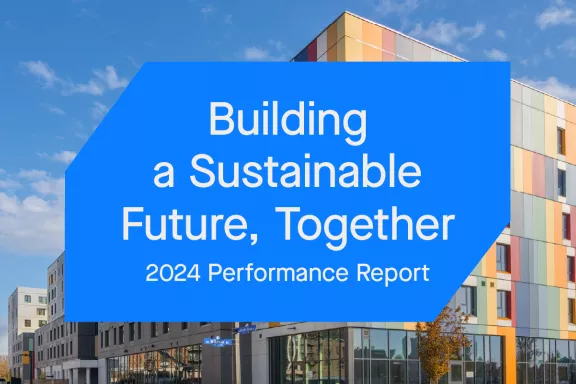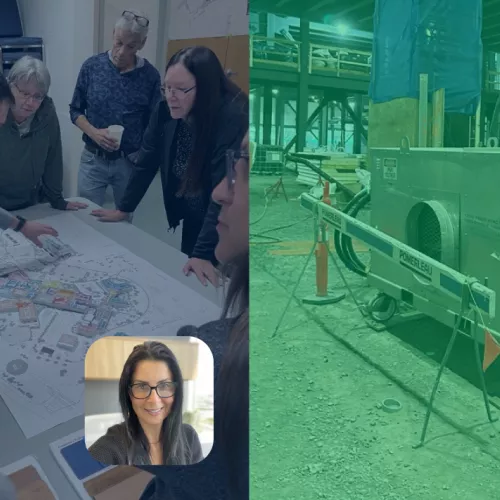

In response to the climate emergency and growing infrastructure needs, Canada’s construction industry is being called to reinvent itself. In this context, Pomerleau, alongside eight other major companies, contributed to the report Growing and Greening Canadian Construction, published by the Transition Accelerator. This document offers a strategic roadmap to reduce greenhouse gas (GHG) emissions on construction sites while enhancing the sector’s competitiveness.
An unprecedented nationwide analysis
The report is based on a study of 617 real construction sites across the country, making it the most comprehensive analysis ever conducted of the sector's emissions. It identifies the main sources of emissions: diesel (65%), gasoline (15%), and natural gas (13%), and proposes concrete solutions to reduce them. Remote sites, which rely heavily on diesel, have the highest emission intensities, while projects connected to the electricity grid show significantly lower impacts.
Five levers for building better and emitting less
The report highlights five priority actions, assessed based on their technical feasibility, economic viability, and environmental impact.
1. Electrifying light vehicles and small equipment
This measure, already initiated by Pomerleau, enables a reduction of up to 15% in emissions. Thanks to mature technology and minimal operational adjustments, it represents a rapid and effective solution.
2. Optimizing and electrifying temporary heating
Heating, particularly in cold climates, is a major source of emissions. Optimizing systems, combined with electrification, can reduce emissions by up to 10%, while improving worker comfort and reducing fuel costs.
3. Adopt renewable diesel as a transition fuel
For heavy equipment that is difficult to electrify, renewable diesel offers an immediate reduction of 40 to 80% in emissions per liter. This measure can contribute up to 25% of a project's total reduction.
4. Connect construction sites to the electricity grid
Rather than using diesel generators, connecting to the grid can reduce emissions by up to 15%, while also reducing noise and operating costs.
5. Deploy hybrid or electric excavation equipment
Although the technology is still developing, this equipment can reduce emissions by up to 10%, paving the way for wider adoption in the coming years.
An Ambitious but Realistic Timeline
The report proposes a gradual and pragmatic path to achieve the sector's decarbonization goals:
By 2030: A 25% reduction in emissions is achievable through the early adoption of four key measures: vehicle electrification (5%), heating optimization (5%), adoption of renewable diesel (10%), and grid connection (5%).
By 2035: A 55% reduction could be achieved with large-scale implementation, notably through increasing the use of renewable diesel (20%) and the early deployment of electric excavation machinery.
By 2040: The sector could achieve a 75% reduction, with renewable diesel as the main driver (25%), followed by vehicle electrification and grid connections (15% each).
This timeline takes into account operational constraints, equipment renewal cycles, and organizational readiness for change. It provides companies with a solid foundation for planning their investments and aligning their sustainability strategies with national climate objectives.
The most committed companies, like Pomerleau, can even accelerate these timelines and achieve higher reductions as early as 2030 by leveraging innovation, training, and cross-sector collaboration.
Transforming the Industry Through Collaboration
The success of this transition does not rest solely on the shoulders of manufacturers. It requires concerted action across the entire value chain:
Construction companies: By leveraging their collective purchasing power, they can stimulate the adoption of clean technologies, train the workforce, and create structural demand in the market.
Equipment manufacturers: They could expand their electrical product lines, offer training to operators, and propose flexible leasing arrangements to facilitate adoption.
Energy distributors: By simplifying grid connection processes and developing charging infrastructure, they enable widespread electrification of construction sites.
Fuel distributors: They play a key role in securing renewable diesel supply chains and raising customer awareness.
Governments: By maintaining incentives for the adoption of clean technologies and integrating sustainability requirements into public tenders, they can accelerate the sector's transformation.
This coordinated approach not only reduces emissions, but also stimulates economic growth, strengthens business competitiveness and improves project performance: reduced operating costs, increased schedule reliability, enhanced quality and safer workplaces.
Pomerleau: Building differently, starting now
By actively participating in this report and implementing several of its recommendations, Pomerleau is reaffirming its leadership role in carbon-neutral construction. We are committed to innovation, collaboration, and responsibility to build a greener future. To discover Pomerleau's concrete initiatives:

